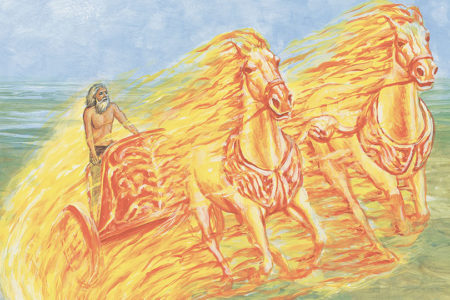The Rapture Question
Many Christians are confused about what is meant by the Rapture of the church and Christ’s Second Coming. Are they one event or two separate events? Some people are even asking, “What is the Rapture of the church?” “Why do Christians hold different views on the Rapture?” Today, more than ever, these questions and many others arise as believers anticipate the Coming of the Lord.
The word rapture is not found in the Bible. It is the Latin verb rapto, which means “to seize” and “to carry off,” taken from the phrase “caught up” in 1 Thessalonians 4:17. The Rapture can be defined as Christ’s descending from heaven in the air, whereupon Christians (dead and alive) will be caught up suddenly from the earth to meet the Lord. At that time, Christians, both dead and alive, will receive their glorified bodies, be taken to heaven, and dwell with Christ forever.
The key question is not whether there will be a Rapture of the church but when the Rapture will take place. Because no specific Scripture in the Bible pinpoints the exact occurrence of the Rapture, Christians differ concerning the timing of this event. Following is a cursory look at the four major views on this subject.
The Pretribulation Rapture
The Pretribulation Rapture view is widely held by Christians. Pretribulational rapturists believe the church will be removed from the earth before the seven-year Tribulation of Daniel’s seventieth week (Dan. 9:24–27). “In a moment, in the twinkling of an eye, at the last trump” (1 Cor. 15:52), believers in Christ (both dead and alive) will be caught up together, meeting the Lord in the air to be with Him forever. This view teaches that the seven years of the Tribulation are divided into two sections of three and one-half years. The first division is called the beginning of birth pangs, and the second is the Great Tribulation.
Those who hold the pretribulational view do so for the following reasons. First, they believe that the Scripture passages dealing with the Rapture must be interpreted literally, not allegorically.
Second, they believe the Rapture of the church is imminent. It could occur at any moment. That is, no signs or events must precede the Rapture. James said, “the coming of the Lord draweth near [is at hand]. . . . behold, the judge standeth before the door” (Jas. 5:8–9). The apostle Paul taught an imminent Rapture when he said “that we who are alive and remain unto the coming of the Lord shall not precede them who are asleep” (1 Th. 4:15).
Third, they believe the Rapture and Christ’s Second Coming are separate events. In the Rapture, Christ does not come to earth; Christians meet Him in the air, go to dwell in heaven, are taken out before the Tribulation, and receive their glorified bodies at that time. At the Second Coming, Christians descend from heaven with the Lord to the earth in their glorified bodies.
Fourth, a division of time must exist between the Rapture and Christ’s Second Coming for specific events in heaven to take place: Christians are living with the Lord in their dwelling place in heaven during the Tribulation (Jn. 14:1–3), and the church will experience the Bema Seat Judgment and the Marriage Supper of the Lamb in heaven during the time the Tribulation is taking place on earth.
Fifth, the church will not experience any form of God’s wrath. Paul said, “For God hath not appointed us to wrath” (1 Th. 5:9). Earlier in 1 Thessalonians, Paul said that Jesus “delivered us from the wrath to come” (1 Th. 1:10). The apostle John told the church at Philadelphia that God would “keep thee from the hour of temptation [testing], which shall come upon all the world” (Rev. 3:10). This promise has much broader application than to the church at Philadelphia because it refers to a specific period of testing, or tribulation, that will afflict the whole world. To be protected from (“out of,” not “in”) this time, the church must be removed from the earth prior to it.
Sixth, it is clear from Scripture that the church and Israel are not identical. God has a separate program for each, especially during the Tribulation period. This is indicated in Daniel 9:24–27, a key passage giving an overview of the Tribulation. The angel Gabriel informed Daniel about God’s future program for Israel. Gabriel said that God would deal with Israel for seventy weeks of seven years each, or four hundred ninety years. Those years are divided into three sections. The first seven weeks of years (49 years) deal with the return of the Jewish people from Babylon and the rebuilding of the city of Jerusalem. The second section of sixty-two weeks (434 years) covers the rebuilding of Jerusalem until the Messiah is cut off (Jesus’ crucifixion). Between the end of the sixty-nine weeks (483 years) and the beginning of the seventieth week is a gap of at least two thousand years.
This third, one-week section, known as Daniel’s seventieth week, or the Tribulation period, has not taken place yet. During this two thousand-year interval, the church came into being. The seventieth week of Daniel will not begin until the Antichrist will “confirm the covenant” (Dan. 9:27) with the nation of Israel. Daniel’s seventieth week is clearly central to Israel’s redemption and blessing, not to that of the church. Daniel 9:24–27 deals exclusively with Israel; the church does not fit into the context of this passage in any form.
Furthermore, the church is never mentioned or eluded to in any of the key passages dealing with the Tribulation. This fact is clearly evident in Revelation chapters 6–19 where Israel and the nations are mentioned, but the church is conspicuously absent.
The Partial Rapture
Those holding a Partial Rapture view teach that some Christians, not all, will be removed from the earth before God pours out His wrath during the Tribulation. Only those who are faithfully living for Christ and counted worthy will be raptured. Christians left behind will be raptured throughout the Tribulation as they set their lives in order. According to this view, the Tribulation will purify worldly Christians, qualifying them to be raptured. These Christians, called “overcomers,” will be waiting and watching for the Lord to rapture them to heaven.
Those holding a Partial Rapture view use the following passages as a Scriptural foundation to try to prove their point: Matthew 24:40–51; 1 Thessalonians 5:6–10; 2 Timothy 4:8; and Revelation 3:3–10. However, these passages are often misinterpreted or quoted out of context and fail to distinguish between the church and Israel.
Midtribulation Rapture
Adherents to this view believe the church will be raptured at the midpoint of the seven-year Tribulation period, after three and one-half years have elapsed. Since the latter half of Daniel’s seventieth week is when God’s wrath will be poured out, midtribulationalists believe the church will not be lifted out of the world before then. Thus this position is called midtribulational.
Midtribulationalists hold this view for the following reasons: First, they believe the church has been promised tribulation and persecution (2 Tim. 3:12). Second, the seventh trumpet that sounds in Revelation is the same trumpet mentioned in 1 Corinthians 15:52, whereupon the church is at the midpoint of the Tribulation. The sounding of the seventh trumpet heralds the beginning of the Great Tribulation of God’s wrath on the earth (which the church will escape), for John declared that the time of God’s wrath “is come” (Rev. 11:18). Midtribulationalists believe that the use of the word wrath here means that nothing preceding the seventh trumpet judgment is considered God’s wrath. Therefore, the seven seal and six trumpet judgments poured out earlier in the book of Revelation do not constitute the wrath of God but rather are man’s or Satan’s wrath on humankind. Thus this view holds that the church will experience the wrath of man and Satan during the first three and one-half years of the Tribulation, but it will be removed before God’s wrath begins in the second half of the Tribulation.
Those holding this view do believe, however, that the Rapture of the church and Christ’s Second Coming are separate events.
Posttribulation Rapture
The Posttribulation Rapture view is widely held by many Christians today. Its proponents believe that the church will endure Daniel’s seventieth week and will be raptured at the end of the Great Tribulation. They also teach that the Rapture of the church and Christ’s Second Coming are the same event.
Yet posttribulationalists hold differing positions of this view. Some teach that events of the Tribulation are not to be taken literally or futuristically, for the church has always undergone tribulation since its inception and is in the Tribulation now.
These people embrace the imminent return of Christ, seeing the Rapture and the Second Coming as one simultaneous event. This position employs both literal and allegorical interpretations of Scripture.
Others teach that the church is in tribulation now; but since some prophecies still need to be fulfilled, the Rapture/Second Coming is not an imminent event. Adherents to this position believe in a seven-year Tribulation before Christ’s Second Coming but are unclear on the sequence and literalness of the events leading up to Christ’s Coming. They, too, mix literal and allegorical interpretations, providing differing interpretations within the position.
Still others who teach that the church will go through a seven-year period of tribulation prior to Christ’s Second Coming interpret the books of Daniel and Revelation more literally than the other posttribulationalists, but make no distinction between the church and Israel.
A final view tries to harmonize Dispensationalism (a view of theology that teaches a strong separation between Israel and the church) and Posttribulationalism (which usually does not). This approach sees distinctions between the church and Israel. The church will go through the seven years of tribulation but will escape the wrath of God during this time because most of the Tribulation events are considered a result of Satan.
Some Posttribulationalists are premillennial and believe that immediately after the church meets the Lord in the air, it will return with Him to live on earth throughout the Millennium (Christ’s thousand-year reign on earth). Others believe that the church meets the Lord in the air and goes directly to heaven to live there eternally.
Despite this proliferation of views, Christians need not be confused regarding the correct teaching of Scripture. The Pretribulation Rapture interpretation is the strongest position because it takes a literal interpretation of key Scriptures bearing on the Rapture of the church. Most advocates of a Posttribulation Rapture do not interpret Scripture literally but allegorically, making the interpreter, not the Scripture, the final authority. Also, although some of the other positions claim to maintain that the Rapture of the church is imminent, only pretribulationalists hold that Christ’s imminent return is a signless event. And lastly, the pretribulational view is the only view that consistently separates God’s program for the church from His program for Israel.








I also think about when Enoch walked with out and then was not and Elijah and the fiery chariot. Also, when Phillip was with the Ethiopian and then was then caught up north from where he was in the blink of an eye.
We as believers don’t deny those rapture like examples happening, without using the word itself. Also with a road so narrow to Christ even the non believers who listen to our discussions lean to the post tribulation, that is enough to make me question it myself. I know that we need to be ready either way.
I asked to David Levy, I want to know if that the body of Christ, whose are the fifth saints tribulation is a part of it?
I also, the Holy Spirit still going to through the first half of the tribulation because the 144K witnessing to people will receive the Holy Spirit until the man of sin will take it over therefore the Holy Spirit will leave immediately?
I has had struggle with fit in 2Thessalonians 2:3? can you explain it to us as soon as feel free time.
The Holy Spirit isn’t removed from the earth. He still plays a role in salvation, conviction, drawing, etc. If He were removed, there’d be no salvation occurring on earth during the Tribulation. But as we see in Revelation 7:9-17, there are multitudes being saved during this time. The church, the bride of Christ, is closed with the rapture thus ending the church age but not closing out the dispensation of grace. Anyone saved after the rapture is a tribulation saint but not a church saint. They will reside and reign on earth whereas church saints will reside in and reign from New Jerusalem.
The pre-tribulation view is definitively the correct view. While there are some people who see them as two separate events there are some who see them as the same event but in separate stages. It’s one of the few times where differing views are actually correct. The second group sees them as separate stages because they view the rapture in terms of the first resurrection which actually happens in 3 stages. Stage 1 was the resurrection of Christ, 1 Corinthians 15:20, stage 2 is the rapture when the saints of the church age are resurrected and stage 3 is at the revelation where Jesus sets His feet on the Mount of Olives. According to Daniel 12:2 this is when Old Testament saints are resurrected along with the martyred saints of the Tribulation period. Regardless of how you choose to view the pre-trib rapture the important thing to remember is that it is our blessed hope and we need to be prepared for it as if it could happen at any moment, not tomorrow, but today. Incidentally, 2 Timothy 4:8 says there’s a crown associated with discerning the correct timing and being prepared for it in the prescribed manner. Not only did Paul mention it but Jesus did as well in Revelation 3:11
Thanks David for the explanation provided in this piece providing clear cut distinction between all views on the Rapture. As your concluding sentence pinpoints also, I believe the pretribulationism is correct.